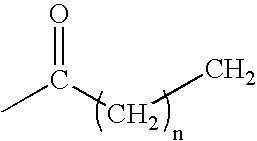Compositions for preparing low dielectric materials containing solvents
- Summary
- Abstract
- Description
- Claims
- Application Information
AI Technical Summary
Benefits of technology
Problems solved by technology
Method used
Image
Examples
example 1
[0085] 22.5 g tetraethylorthosilicate (TEOS) and 22.5 g of methyltriethoxysilane (MTES) were added to 100 g of 1-pentanol and mixed thoroughly. 9.67 g of purified Triton X-114 was added to the silicate solution and agitated to obtain a homogeneous solution. In a separate bottle, 1 g of 2.4 wt % tetramethylammonium hydroxide in water (TMAH) was added to 24 g of 0.1 M nitric acid (HNO3). The HNO3 solution was added directly to the silicate solution. The entire composition was agitated for ˜30 minutes.
[0086] After allowing the composition to sit at ambient conditions for 12 to 24 hrs., the composition was filtered through a 0.2 micron Teflon filter. Approximately 1.2 milliliters (mls) of composition was dispensed onto a 4″ Si wafer in an open bowl configuration while spinning at 500 rpm for 7 seconds. At the completion of the dispense step, the wafer was accelerated to 1800 rpm for 40 seconds to complete the evaporation process.
[0087] The wafer was then calcined in air at 90° C. for ...
example 2-13
[0088] The same procedure that was used in example 1 was repeated except that 100 g of the solvent or a 50 / 50 mole percent mixture of solvents with the appropriate combination of boiling point, surface tension, viscosity, and solubility parameter were used in place of the 1-pentanol. Examples 2-5 and 12-13 are comparative compositions that use one or more solvents that fall outside the preferred ranges of physical and chemical properties. The properties of films made from compositions 1 through 13 are provided in Table II.
TABLE IIDielectricDe-Example #SolventConstantHomogenousStriationswettingUniformity2dipropylenen / tyesyesyesno(Comparative)glycol3propylenen / tnoyesyesno(Comparative)glycol(emulsion)4diacetonen / tnoyesyesno(Comparative)alcohol(two-phase)5Cyclohexanonen / tyesyesnono(Comparative)(particles)12 Ethanol2.05yesyesnoyes(Comparative)13 ethyl acetate2.06yesyesnoyes(Comparative)6propylene2.06yesnonoyesglycol propylether72-methyl-1-2.07yesnonoyespentanol11-pentanol2.07yesnonoyes...
example 14
[0090] 97.3 g TEOS, 97.3 g MTES, 497.3 g of 1-pentanol, and 108.1 g of a catalyst solution (103.7 g of 0.1 M HNO3, and 4.3 g 2.4 wt % TMAH) were combined together and mixed until homogeneous. The solution was stirred at 60° C. for 2 hours. After 2 hours at 60° C., the solution was concentrated by removing ˜20 wt % of the volatile components from the mixture using a rotary evaporator at 60° C. (removed 160 g of ethanol, water, and pentanol). The solution was cooled back to room temperature. 160 g of 1-pentanol was added to the formulation and stirred until homogeneous. 69.9 g of Triton X-114 was then added to the solution and mixed to insure homogeneity of the composition.
[0091] After aging at room temperature for 16 to 24 hours, the composition was filtered through a 0.2 micron Teflon filter. 4 mls of the filtered composition was dispensed, in a process tool with an open spinning bowl configuration, onto a 8″ Si substrate spinning at 500 rpm (dispense time ˜8 seconds) before accele...
PUM
| Property | Measurement | Unit |
|---|---|---|
| Temperature | aaaaa | aaaaa |
| Temperature | aaaaa | aaaaa |
| Temperature | aaaaa | aaaaa |
Abstract
Description
Claims
Application Information
 Login to View More
Login to View More - R&D
- Intellectual Property
- Life Sciences
- Materials
- Tech Scout
- Unparalleled Data Quality
- Higher Quality Content
- 60% Fewer Hallucinations
Browse by: Latest US Patents, China's latest patents, Technical Efficacy Thesaurus, Application Domain, Technology Topic, Popular Technical Reports.
© 2025 PatSnap. All rights reserved.Legal|Privacy policy|Modern Slavery Act Transparency Statement|Sitemap|About US| Contact US: help@patsnap.com


